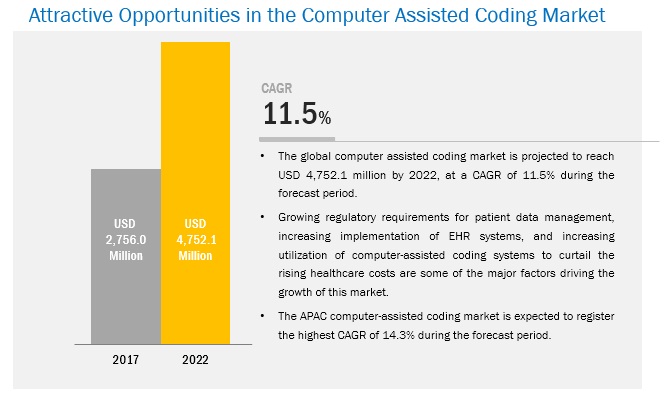The CAC market is expanding with the emergence of new products and applications. These computer assisted coding solutions being used in many applications such as automated computer-assisted encoding, management reporting & analytics, and clinical coding auditing.
What the Computer Assisted Coding Market Looks Like?
Predicted to grow at a CAGR of 11.5% during the forecast period, the global Computer Assisted Coding Market is estimated to reach USD 4.75 Billion by the end of 2022. The growth of the market can be attributed to the transition to ICD-10 coding standards from ICD-9 in North America, the growing demand for CAC solutions, the growing need within the global healthcare system to curtail increasing healthcare costs, improve coding accuracy, and streamline the revenue cycle management procedures.
Implementation of ICD-10 Drive the Global Computer Assisted Coding Market
Many hospitals, especially in North America, are adopting CAC systems to manage the increasing load of coding resulting from the adoption of ICD-10 standards. Major health plans like Medicare have reported a smooth transition to ICD-10 due to rigorous testing for over six years. The ICD-10 coding system requires the use of 72,000 procedure codes and 68,000 CM codes, as opposed to the 4,000 and 14,000 codes, respectively, in the ICD-9 system. The requirement of managing a high volume of codes in the ICD-10 system is in turn driving the demand for automation.
The US is expected to dominate the global CAC market due to the mandated switchover to ICD-10 coding standards in October 2015. This transition may result in a decline in coders’ productivity, thereby resulting in lower profitability for hospitals. The implementation of CAC systems can resolve this issue as they enable healthcare organizations to work more efficiently while complying with procedural coding standards as per ICD-10 guidelines. This trend is expected to provide a strong stimulus to the growth of the CAC market in North America in the coming years.
Download PDF Brochure @ https://www.marketsandmarkets.com/pdfdownloadNew.asp?id=170644018
What Drives the Computer Assisted Coding Market?
The growth of the global market for computer-assisted coding is primarily influenced by the following factors:
+ Growing adoption of CAC solutions in North America due to the implementation of ICD-10 standards
+ Increasing implementation of EHR systems
+ Increasing utilization of CAC solutions to curtail the rising healthcare costs
+ Growing regulatory requirements for patient data management
+ Growing focus on physician computer-assisted coding in outpatient settings
Geographical growth scenario of Computer Assisted Coding Market
Geographically, the CAC market in APAC is expected to grow at the highest CAGR during the forecast period. The growth of this region is primarily driven by the escalating demand to reduce the burden of the healthcare systems, curtail healthcare delivery costs, increasing implementation of Healthcare IT solutions, and the various government initiatives for enabling efficient, affordable, and on-time delivery of quality care. As a result, APAC holds a significant share of the overall computer assisted coding market.
Request for Sample Pages @ https://www.marketsandmarkets.com/requestsampleNew.asp?id=170644018
Leading market players and strategies adopted
Key players in the CAC Market include 3M Health Information Systems (US), Optum (US), McKesson Corporation (US), Nuance Communications (US), Cerner Corporation (US), Dolbey Systems (US), Precyse Solutions (nThrive) (US), Craneware (UK), Artificial Medical Intelligence (US), and TruCode (US). Other players include Quest Diagnostics (US), Streamline Health Solutions (US), M-scribe Technologies (US), eZDI Inc. (US), Alpha II LLC. (US), ID GmbH & Co. KGaA (Germany), ZyDoc (US), Coding Strategies (US), Patient Code Software (US), and Flash Code (US) among others. These players are increasingly undertaking mergers and acquisitions, and product launches to develop and introduce new computer assisted coding solutions in the market.

